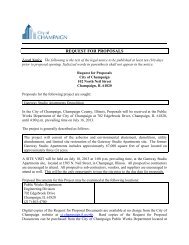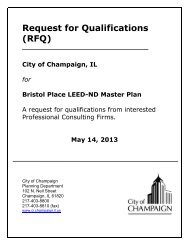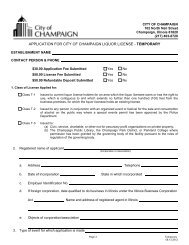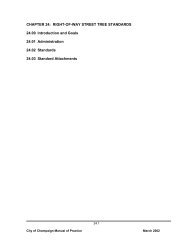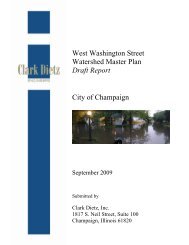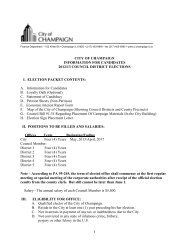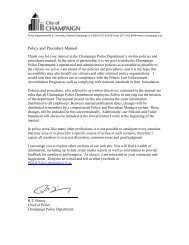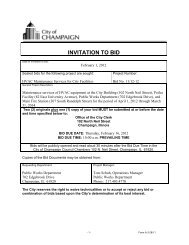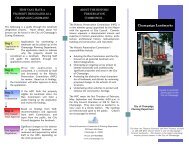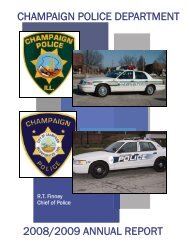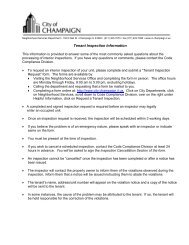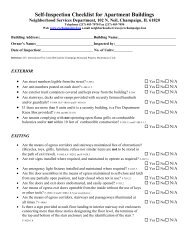2010-2014 Consolidated Plan - City of Champaign
2010-2014 Consolidated Plan - City of Champaign
2010-2014 Consolidated Plan - City of Champaign
Create successful ePaper yourself
Turn your PDF publications into a flip-book with our unique Google optimized e-Paper software.
FY <strong>2010</strong>/11 AAP Chapter 2:Geographic Distribution and Housing Market AnalysisCOMMUNITY PROFILEThe <strong>City</strong> <strong>of</strong> <strong>Champaign</strong> is located in east central Illinois approximately 135 miles south <strong>of</strong> Chicago and 80miles northeast <strong>of</strong> Springfield, the state capital. Its adjoining twin city, Urbana, is the county seat.<strong>Champaign</strong>-Urbana is the home <strong>of</strong> the University <strong>of</strong> Illinois. Parkland Community College is also locatedin <strong>Champaign</strong>.The 2000 Census listed <strong>Champaign</strong>'s population at 67,518, comprising 38% <strong>of</strong> the total county population<strong>of</strong> 179,669. The Bureau <strong>of</strong> the Census estimates the <strong>City</strong>’s 2002 population to be 69,443. According toCensus figures the <strong>City</strong>'s population grew by 6% between 1990 and 2000. This growth was due toannexation <strong>of</strong> adjacent land parcels, growth <strong>of</strong> the University <strong>of</strong> Illinois, and in-migration. A specialCensus was completed recently to include a large area <strong>of</strong> annexed land and its corresponding populationinto the total for <strong>Champaign</strong>. The 2007 Special Census estimates the current population <strong>of</strong> <strong>Champaign</strong> at75,200.Students comprise approximately 32% <strong>of</strong> the <strong>City</strong>’s population. This large number <strong>of</strong> students has asignificant impact on the housing market, particularly the rental housing market. The willingness <strong>of</strong>students to share living quarters and pay inflated rents for short periods <strong>of</strong> time tightens the rentalmarket and has the effect <strong>of</strong> raising rents citywide.According to the 1990 Census, 73% <strong>of</strong> <strong>Champaign</strong>’s citizens are white, 16% are black, 7% are Asian, and4% are Hispanic. The median age in 2000 was 24, reflecting the presence <strong>of</strong> the University <strong>of</strong> Illinoisstudent population, and 8% <strong>of</strong> the population was over the age <strong>of</strong> 65.In 2000, the <strong>City</strong>’s median household income was $32,795 and the median family income was $52,628.The number <strong>of</strong> families living below the poverty level in 2000 was 1,021, or 8.2% <strong>of</strong> the population.NEIGHBORHOOD WELLNESS PLANNING AREASThe <strong>City</strong>’s Neighborhood Wellness <strong>Plan</strong> update process was conducted concurrently with the preparation<strong>of</strong> the 2005-2009 <strong>Consolidated</strong> <strong>Plan</strong>. The Wellness <strong>Plan</strong> assesses the physical and social conditions <strong>of</strong>each <strong>of</strong> the <strong>City</strong>’s neighborhoods. Data is collected andanalyzed in the following areas: housing conditions, realestate market trends, property maintenance, population anddemographic characteristics, civic involvement, householdeconomic conditions, infrastructure, and public safety. Thisdata collection and analysis process was completed in the fall<strong>of</strong> 2004. Because this neighborhood data forms the basis formuch <strong>of</strong> the needs analysis portion <strong>of</strong> the <strong>Consolidated</strong> <strong>Plan</strong>,the Annual Action <strong>Plan</strong> frequently refers to planning areas.The <strong>City</strong> is divided into 25 planning areas, as shown here. Acomparison between planning areas and low/moderateincomeCensus Tracts is provided below. A full page version<strong>of</strong> this map is also provided in Appendix B.HOUSING MARKET SUMMARYThere are 28,556 housing units in the <strong>City</strong> <strong>of</strong> <strong>Champaign</strong>.This is up 10% from 1990. The <strong>City</strong>’s current vacancy rate is5%, which is an acceptable rate according to real estateindustry standards. The University <strong>of</strong> Illinois significantlyFY <strong>2010</strong>/11 Annual Action <strong>Plan</strong>: Geographic Distribution and Housing Market Analysis 103



